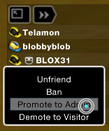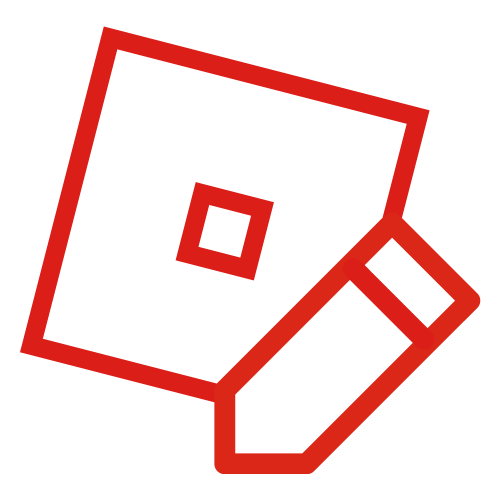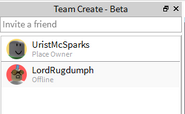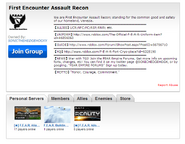
Personal Server sign.
Personal Servers were a type of place on Roblox in which owners, admins and certain players can build and have the place automatically save progress periodically. Unlike regular places, they were allowed to only have one server running. The default building tools given to builders were the stamper tool and its associated complements. They were discontinued according to Roblox on June 8, 2016, and were later removed. As a result, all personal servers were converted to regular places.
Players were able to join and help build with the owner of the game. Restrictions could be made by the owner such as on who can visit, who can build, and who is banned. Personal servers usually relied on legacy terrain.
Users must have a Builders Club membership to be able to make a Personal Server. However, any player could join a Personal Server without Builders Club. When the place owner's Builders Club membership expires, the server is still kept, but another server cannot be made. Also, if the place is changed into a regular type, it cannot be made into a Personal Server until the place owner owns a Builders Club membership again.
History

ROBLOX RALLY-Three ROBLOX administrators introduce personal servers at the 2011 ROBLOX Rally.
Personal servers were first introduced by Njay, ostrichSized, and gen2integri at the 2011 Roblox Rally. The feature was fully released on November 2, 2011.[1]
Initially, Personal Servers had their own tab besides regular places on the front page. Because personal servers had a player limit of 50, this helped to allow them to have exposure. Roblox later removed this tab sometime in 2013 greatly reducing the flow of new players to Personal Servers.
On May 26, 2016, it was discontinued to be replaced with Team Create. Without a concrete reason, personal servers were discontinued on June 8, 2016, according to a message from Roblox and on the forums.
On August 19, 2016, Legacy Terrain was removed and converted to Smooth Terrain causing the vast majority of builds to be ruined.
On October 27, 2016 Build Mode was also removed, disallowing the creators from continuing their builds personally.
Features
Roblox describes a personal server as "a game that never closes."[2] Unlike a regular game place, when a server closes when all players have left, a personal server never closes. Therefore, the personal server never reverts to the way it was before users started playing it; this creates the opportunity for personal servers to be used as collaborative building projects. Personal servers can be changed back to a game place and vice versa.
The following is a chart explaining the differences between a personal server and a game place:
| Personal Server | Game Place | |
|---|---|---|
| Autosaves | ||
| Single Instance | ||
| Public by Default | ||
| Private by Default | ||
| Access Privileges | ||
| Ban List | ||
| Gear Allowed | ||
| Tickets Awarded for Visitors Before Removal | ||
| Builders Club to Create | ||
| Free to Play |
Access Levels

How to promote/demote a user within a personal server
- The owner and administrators can assign access levels to specific users via clicking the player's name on the leaderboard. These access levels dictate what permissions that player has and what he can and cannot do within the personal server.
The following is a chart explaining the certain permissions various access levels have within a personal server:
| Banned | Visitor | Member | Admin | Owner | |
|---|---|---|---|---|---|
| Ability to play game | |||||
| Ability to use build tools | |||||
| Ability to promote/demote other users* | |||||
| Ability to add and remove administrators |
*Except promotion/demotion of administrators
It is advised to be cautious when promoting players. Any changes they make to the server, whether constructive or destructive, will be automatically saved. Fortunately, the place can be quickly restored to a previous save file before an unwanted change to reverse it.
Personal Servers within Groups
Personal Servers can be associated with particular groups. A feature of personal servers allows building rights and admin to be automatically granted to group members based on ranks of the creator's choosing. Like associating a place with a group, associating a personal server with a group made that personal server appear on the group's page.
The Personal Server Culture
Large communities formed in many Personal Servers. They could create a Roblox group to further assign and divide the permissions of players.
There were a multitude of popular genres. Building servers were common. Two types of building servers were common. Free-builds were servers that allowed everyone to build anything they wanted. It was a way to allow players without Builder's Club to experience Personal Server-style building. There were also servers that had specific objectives in their builds be it a city or a building. Games in which visitors did not build were also popular. Examples would be roleplays such as town, school, and others, businesses such as airlines, hotels, and theme parks, obbies, tournaments such as races or swordfights, minigames such as musical chairs,Even nations, and many others.
External tools were often inserted into personal servers. Scripted admin was commonly added. F3X and other custom building tools were also frequently added as alternatives to the traditional stamper tool.
Even though many builds utilized custom building tools, stamper tool purists were also present. They built exclusively or almost exclusively using the stamper tool, embracing its simple functioning and aesthetic. Some employed wiring to create contraptions that ran on inputs and outputs. Many machines used float pads to power devices ranging from simple rockets and catapults to more complex mechanisms such as multi-floor elevators and mechanical claws. Seeing as wiring was an often overlooked feature and its wider capabilities even more so, this type of building was not nearly as common as static buildings.
Long-lasting personal servers would develop into vibrant hubs. A thriving Personal Server often contained frequenters (e.g. active inhabitants in city servers), and was able to continuously develop, Such as PBS nations.
Criticism and issues
An issue with Personal Servers was griefing. This often occured in Personal Servers in which building rights were handed out too freely. Griefers would sabotage a place through means such as flooding the map with water or blowing it up using C4 and explosive gear. However, this was easily remedied. All that was needed was to simply remove the building rights of the known griefer to prevent further griefing from the individual and revert back to an earlier version before the griefing to completely restore the map to its previous form.
Personal Servers were often claimed to be a useless feature. Those with that opinion often say that many types of games on Personal Servers could be done in normal places (games such as, quiz games, RP games, and minigame places). While they could also be created in a regular place, Personal Servers provided simple and easy and easy way for a host to manually operate the game. Regular game places generally automated the processes using scripts. This argument ignores the fact that the host interaction is often what set Personal Servers apart. Another argument was that Personal Servers were a poor collaborative development tool. This ignores the fact that the majority of Personal Servers were games in and of themselves.
The stamper tools that came with Personal Servers were also prone to develop bugs overtime. Examples would be, cloning a brick connected to a larger structure would cause the structure to erratically shift and deform, moving a brick connected to a larger structure using the 4x4 movement option would do something similar to the aforementioned clone tool problem, structures built using the basic building blocks would start to develop strange cracks and slowly shift as more was added to the structure, and the wiring tool and configure tool were prone to randomly breaking in servers with a high brick count forcing a a reversion to an earlier version to be able to use the tools again. These issues were completely ignored by Roblox who most likely wanted to deemphasize the Personal Server feature and emphasize normal places in accordance with their goal to shift the game in a different direction.
Team Create
Team Create is a similar to Personal Servers in that it allows collaborative building, but players are restricted to building in Roblox Studio instead of being able to do so in-game along with their avatars. Also, players need to invite others to build with them. Team Create was first announced in a blog post on April 13, 2016, while it was in Beta. Here are several images of Team Create:
Differences between Personal Servers and Team Create
- On Personal Servers, players had access to the stamper tool and whichever other tool inside their inventory because their avatar was present, while on team create players do not have access to their avatar.
- Personal Servers had access levels restricted to different players, but team create does not.
- Personal Servers allowed the users to build in-game with their avatar instead of in studio like Team Create.
- Personal Servers had an extra megaphone-like tool that would create thumbnails, like a camera, but this feature isn't available on Team Create.
- While every player can join a Personal Server (except players who are banned from the server), players must be invited to a Team Create.
Gallery
References
- ↑ Roblox Blog, Your Own Personal Server, Version 1.0, http://blog.roblox.com/2011/11/your-own-personal-server-version-1-0/
- ↑ Roblox, What is a Personal Server?, https://en.help.roblox.com/hc/en-us/articles/203314010-What-is-a-Personal-Server-




